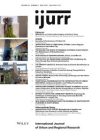Suburban shrinkage, understood as a degenerative urban process stemming from the demise of the Fordist mode of urbanism, is generally manifested in a decline in population, industry and employment. It is also intimately linked to the global restructuring of industrial organization associated with the rise of the post‐Fordist mode of urbanism and, more recently, the thrust of Asian industrialization. Framed in the discourse of industrial urbanism, this article examines the first ring of industrial suburbs that developed around large cities in their most rapid Fordist urbanization phase. These industrial suburbs, although they were formed at different times, are today experiencing specific mutations and undergoing profound restructuring on account of their particular spatial position between the central area and the expanding peripheries of the post‐Fordist metropolis. This article describes and compares suburban decline in two European cities (Glasgow and Paris) and two Latin American Cities (São Paulo, Brazil and Guadalajara, Mexico), as different instances of places asymmetrically and fragmentarily integrated into the geography of globalization.
Details
Written by:
IVONNE AUDIRAC, EMMANUÈLE CUNNINGHAM‐SABOT, SYLVIE FOL, SERGIO TORRES MORAES
Digital Object Identifier (DOI)
10.1111/j.1468-2427.2011.01093.x
About DOI
Read full article as PDF
Read full article as HTML
See the references for this article
